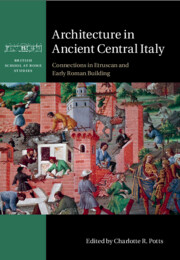Refine search
Actions for selected content:
5894 results in Classical art and architecture
Charts and Tables
-
- Book:
- Architecture in Ancient Central Italy
- Published online:
- 31 March 2022
- Print publication:
- 07 April 2022, pp xi-xi
-
- Chapter
- Export citation
Copyright page
-
- Book:
- Architecture in Ancient Central Italy
- Published online:
- 31 March 2022
- Print publication:
- 07 April 2022, pp iv-iv
-
- Chapter
- Export citation
5 - Connecting Foundations and Roofs
-
-
- Book:
- Architecture in Ancient Central Italy
- Published online:
- 31 March 2022
- Print publication:
- 07 April 2022, pp 125-147
-
- Chapter
- Export citation
2 - The Silent Roofing Revolution
-
-
- Book:
- Architecture in Ancient Central Italy
- Published online:
- 31 March 2022
- Print publication:
- 07 April 2022, pp 31-61
-
- Chapter
- Export citation
7 - Connections in Death
-
-
- Book:
- Architecture in Ancient Central Italy
- Published online:
- 31 March 2022
- Print publication:
- 07 April 2022, pp 174-199
-
- Chapter
- Export citation
Contents
-
- Book:
- Architecture in Ancient Central Italy
- Published online:
- 31 March 2022
- Print publication:
- 07 April 2022, pp v-v
-
- Chapter
- Export citation
6 - Architectural Choices in Etruscan Sacred Areas
-
-
- Book:
- Architecture in Ancient Central Italy
- Published online:
- 31 March 2022
- Print publication:
- 07 April 2022, pp 148-173
-
- Chapter
- Export citation
Notes on the Contributors
-
- Book:
- Architecture in Ancient Central Italy
- Published online:
- 31 March 2022
- Print publication:
- 07 April 2022, pp xii-xiv
-
- Chapter
- Export citation
Frontispiece
-
- Book:
- Architecture in Ancient Central Italy
- Published online:
- 31 March 2022
- Print publication:
- 07 April 2022, pp xvi-xx
-
- Chapter
- Export citation
Index
-
- Book:
- Architecture in Ancient Central Italy
- Published online:
- 31 March 2022
- Print publication:
- 07 April 2022, pp 200-204
-
- Chapter
- Export citation
3 - Architectural Terracottas of Central Italy within Their Wider Mediterranean Context
-
-
- Book:
- Architecture in Ancient Central Italy
- Published online:
- 31 March 2022
- Print publication:
- 07 April 2022, pp 62-94
-
- Chapter
- Export citation

Architecture in Ancient Central Italy
- Connections in Etruscan and Early Roman Building
-
- Published online:
- 31 March 2022
- Print publication:
- 07 April 2022

Gothic Kernow
- Cornwall as Strange Fiction
-
- Published by:
- Anthem Press
- Published online:
- 02 March 2022
- Print publication:
- 11 January 2022
Contents
-
- Book:
- Isis in a Global Empire
- Published online:
- 06 February 2022
- Print publication:
- 24 February 2022, pp v-vi
-
- Chapter
- Export citation
Chapter Seven - Conclusion
-
- Book:
- Isis in a Global Empire
- Published online:
- 06 February 2022
- Print publication:
- 24 February 2022, pp 186-194
-
- Chapter
- Export citation
Chapter Two - Building Groupness
-
- Book:
- Isis in a Global Empire
- Published online:
- 06 February 2022
- Print publication:
- 24 February 2022, pp 29-58
-
- Chapter
- Export citation
Notes
-
- Book:
- Isis in a Global Empire
- Published online:
- 06 February 2022
- Print publication:
- 24 February 2022, pp 201-244
-
- Chapter
- Export citation
Acknowledgments
-
- Book:
- Isis in a Global Empire
- Published online:
- 06 February 2022
- Print publication:
- 24 February 2022, pp xi-xiv
-
- Chapter
- Export citation
Chapter One - Egyptian Religion and the Problem of Greekness
-
- Book:
- Isis in a Global Empire
- Published online:
- 06 February 2022
- Print publication:
- 24 February 2022, pp 1-28
-
- Chapter
- Export citation
Copyright page
-
- Book:
- Isis in a Global Empire
- Published online:
- 06 February 2022
- Print publication:
- 24 February 2022, pp iv-iv
-
- Chapter
- Export citation
